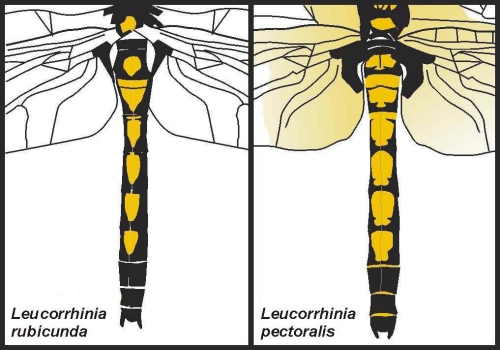Spain, Andalucia, 5-8th June 2012

 |
| Male Orange-spotted Emerald Oxygastra Curtisii |
After leaving Extremadura we headed south to Andalucia. My key target species was Orange-spotted Emerald which is relatively numerous on the Rio Hozgarganta. We based ourselves at the campsite at Jimena which was ideal for exploring the area.
Videograbs from my Trip DVD. See Trip DVD's for sale.
 |
| Teneral Female Orange-spotted Emerald Oxygastra Curtisii |
During our first two days here the temperature got up to about 39 degrees celsius which was even hotter than the we experienced in Extrenadura. This area was superb and we saw some great species. We missed out on Green-eyed Hooktail (Paragomphus genei) as we may have been about a week too early. I was not too concerned I have filmed this species in South Africa.
 |
| Male Splended Cruiser Macromia splendens |
We visited this site on two mornings and saw the following:
6/6/12
Copper Demoiselle (Calopteryx haemorrhoidalis)3
Orange Featherleg (Platycnemis acutipennis) 20
White Featherleg (Platycnemis latipes) 2
Emperor Dragonfly (Anax imperator) 4
Pronged Clubtail (Gomphus graslinii) 2
Western Clubtail (Gomphus pulchellus) 10
Orange-spotted Emerald (Oxygastra curtisii) 6
Splendid Cruiser (Macromia splendens) 2
Epaulet Skimmer (Orthetrum chrysostigma) 6
Scarlet Darter (Crocothemis erythraea) 1
Violet Dropwing (Trithemis annulata) 2
Orange-winged Dropwing (Trithemis kirbyi)2
7/6/12
Copper Demoiselle (Calopteryx haemorrhoidalis)2
Blue-Eye (Erythromma lindenii) 20
Orange Featherleg (Platycnemis acutipennis) 10
 |
| Male Orange-winged Dropwing Trithemis kirbyi |
Emperor Dragonfly (Anax imperator) 2
Orange-spotted Emerald (Oxygastra curtisii) 12
Splendid Cruiser (Macromia splendens) 3
Epaulet Skimmer (Orthetrum chrysostigma) 10
Violet Dropwing (Trithemis annulata) 2
Orange-winged Dropwing (Trithemis kirbyi) 3
Rio Hozgarganta, below campsite, Jimena
We visited this site on twice in search of Green Hooktail Paragomphus genei although we did not locate any. We were possibly a week too early:
6/6/12 Mid Afternoon
Blue-Eye (Erythromma lindenii) 10
 |
| Female Copper Demoiselle Calopteryx haemorrhoidalis |
Orange Featherleg (Platycnemis acutipennis) 2
Epaulet Skimmer (Orthetrum chrysostigma) 3
Violet Dropwing (Trithemis annulata) 3
Orange-winged Dropwing (Trithemis kirbyi) 3
8/6/12 Morning
White Featherleg (Platycnemis latipes) 1
Epaulet Skimmer (Orthetrum chrysostigma) 6
We visited the Dolman pool area below Rhonda in search of Desert Darter although we were unable to find any. We were too early, this site is best visited in August/September for this species. We did however see the following:
 |
| Red-veined Darter Sympetrum fonscolombii |
6/6/12 Late afternoon
Iberian Bluetail (Ischnura graellsii) 1
Common Blue Damselfly (Enallagma cyathigerum)20
Emperor Dragonfly (Anax imperator) 4
Black-tailed Skimmer (Orthetrum cancellatum) 12
Red-veined Darter (Sympetrum fonscolombii) 4
Scarlet Darter (Crocothemis erythraea) 12
7/6/12 Mid afternoon
Common Blue Damselfly (Enallagma cyathigerum) 2
Emperor Dragonfly (Anax imperator) 4
Black-tailed Skimmer (Orthetrum cancellatum) 20
 |
| Sage Skipper |
A number of Butterflies were
seen including:
Black-veined White, Western Marbled White, Purple Shot Copper, Clouded Yellow, Sage, Small, Essex and Southern Marbled Skippers , Wall Brown, Common Blue, Mountain Argus, Lang's Short-tailed Blue, Small Copper and Knapweed Fritillary.
 |
| Large Grizzled Skipper |
We visited a number of other sites:
Laguna de Medina 5/6/12 Late afternoon
Lesser Emperor Dragonfly (Anax parthenope) 1
Banded Groundling (Brachythemis impartita) 3
San Pablo de Buciete 7/6/12 Mid afternoon
Copper Demoiselle (Calopteryx haemorrhoidalis) 1
Blue-Eye (Erythromma lindenii) 1
White Featherleg (Platycnemis latipes) 15
Broad-bodied Chaser (Libellula depressa) 1
Epaulet Skimmer (Orthetrum chrysostigma) 1
Scarlet Darter (Crocothemis erythraea) 1
Violet Dropwing (Trithemis annulata) 3
Orange-winged Dropwing (Trithemis kirbyi) 1
Los Angeles Rio Guadiaro 7/6/12 Mid afternoon
Copper Demoiselle (Calopteryx haemorrhoidalis) 1
Blue-Eye (Erythromma lindenii) 2
White Featherleg (Platycnemis latipes) 10
Violet Dropwing (Trithemis annulata) 3






























































